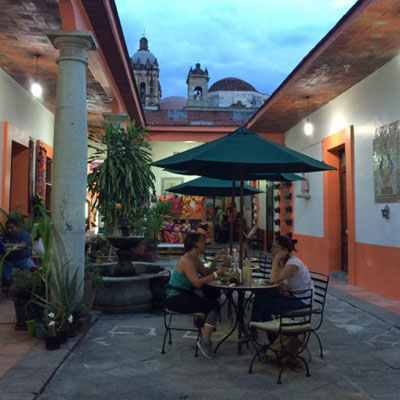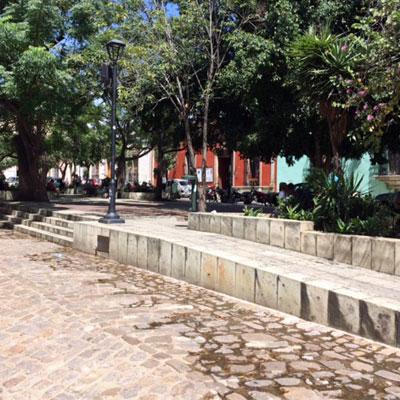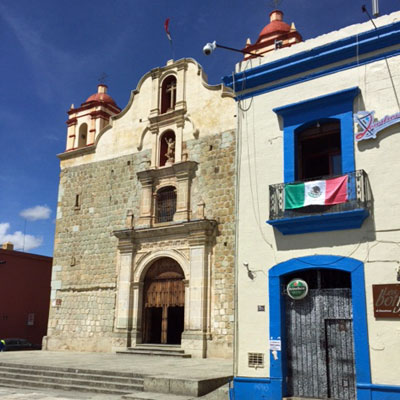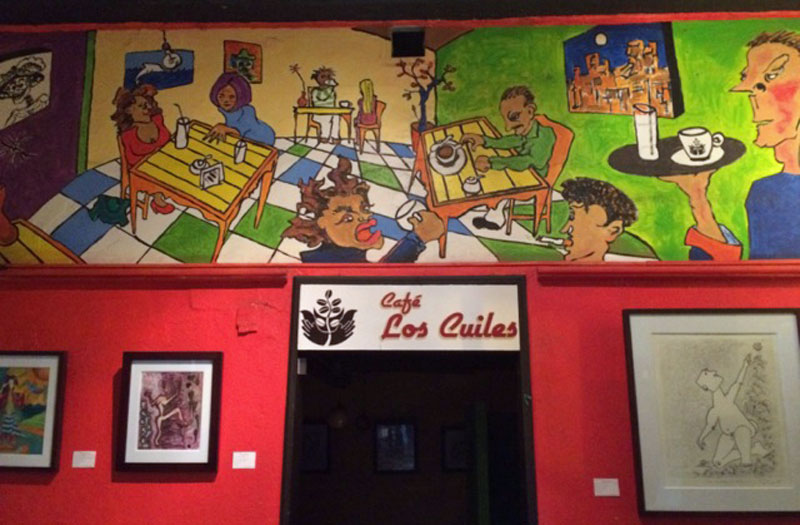¡Dios mío, Dios mío!, ¿por qué me has abandonado?
[My God, my God, Why hast Thou forsaken me?]
“Hello Mr. Jeffrey Farmer.”
There she was, irresistible smile, shiny black straight hair hanging over the strap of her Xochitl shoulder bag. I was happy to see her but tried not to look too anxious.
“Do you mind if I join you?”
“I’m reading, but I can take a break.”
She sat across from me. The tables in the patio at Los Cuiles have colorful tile tops. The chairs, simple black metal frames with cushions on the seats, make a grating sound as you scoot them in or out.

“I’ve been thinking of the story you told before you left so quickly and, I must say, rudely from the party. By the way, Cristina, my goddaughter, loves the rabbit. In fact, it is her favorite present. We can’t get it away from her. She holds it to her face and smells it. Then, she laughs and says ‘Farm, Farm’ which is as close as she can get to your name.”
“I didn’t know what to buy for her. The shop girl picked it out. She said her daughter loves rabbits.”
“Well, anyway, about your story, have you read Unamuno’s Saint Manuel Bueno, Martyr?”
“I’m no Lazaro.”
“I didn’t say you were. Don’t jump to conclusions.”
“The book about that hypocrite priest? Please, spare me.”
“He was no hypocrite and that, in fact, is the point of the book. You must have missed it.”
“San Manuel is an elitist. His philosophy is no better than Napoleon’s religion is what keeps the poor from murdering the rich. He says he deceives the “people” for their own good because they cannot handle the truth, but he is the one who can’t handle it.”
Everything about her changed. I could see I’d struck a chord. Her hands were shaking. That irresistible smile turned to a scowl.
“You are a strange young woman, my Dear. That you’ve read Unamuno is telling, also Blake and Lowry. This makes me wonder what else we have in common. Could it be you that is the hypocrite, a secular hypocrite?”
“I can’t believe this! I thought underneath that façade you were a human being, someone with thoughts maybe even wisdom to share. But no, you are sad and selfish, nothing but a brute.”
She stood up and reached for her bag.
“Don’t be so naïve about human beings, my Dear, and so tough on us when confronted with the truth. Yes, we are both human. Curiosity. Experience—very natural at the surface but underneath nothing but a trivial contemptible acceptance of the state of affairs.”
“STOP CALLING ME “MY DEAR”!”
She yelled at me but she sat back down although she slammed her bag on the table. I was beginning to enjoy this tête-à-tête.
“I’m sorry. Truly. Look, let’s consider the story as I remember it. Perhaps I got it wrong. There’s a priest, he’s not a believer yet he administers to his flock as if he is a believer because he thinks they can’t handle the truth. He deceives them and after admitting his “secret” to Lazaro, also an unbeliever, he asks Lazaro to join him in this charade. And, Lazaro, bewitched by this Grand Inquisitor, agrees. Poor Angela, Lazaro’s sister, worships the priest and her brother but cannot decipher them. In the end, she decides they died thinking they were unbelievers when actually they believed very deeply.”
“Go on.”
“I’m not sure where to go. I can’t see how people are better off being deceived. Society may be safer using the standards of Napoleon, but not individuals. Even if it’s possible to make people happy with a lie, this seems to me like a shallow happiness. San Manuel treats his flock like children just like God the Father. But, human beings are not children.”
I could see the wheels churning. Her body had relaxed. It was amazing how open she was to new ideas.
“Hmm. I came here with what I thought were good arguments to refute the concerns you expressed in your personal story. Now I’m not sure. I’ll have to rethink San Manuel Bueno, Martyr. It’s clearly more complicated than I thought. But, science and art, you must continue with your synthesis. You gave up too easily on that. It is the constant conflict between rationality and irrationality that creates art, real art. I’m sure you know the Einstein quote science without religion is lame, religion without science is blind.”
“Narcedalia, you don’t need to refute anything. I told you a very shortened version of why I’m here in Oaxaca. Simply put, I’ve found the atmosphere in America to be no longer tolerable with this Trompudo and his band of merry pranksters in control. It’s painful to be there right now, so I left. That’s it. Now, there must be more to do here than sit in this café, beautiful as it may be, and discuss religion, science and art. What would you suggest I do, where would you have me go, what would you want me to see to get out of this melancholy mood?”
“You want me to act as your tour guide?”
She started to laugh. I laughed too.
“Not formally. I’ve learned quite a lot about Oaxaca over the years. But, you know, just give me a few pointers toward places or things I might have missed.”
“Get up, Mr. Farmer. Pay your bill. I’ll meet you out front. By then I’ll have an itinerary.”

Café los Cuiles is located in Plaza de los Virgenes just off Parque Labastida. Artists and street vendors used to be located in the park but they have been removed. The park is small and quiet, a peaceful place to sit and read or engage in conversation. Across from los Cuiles there is a school. During breaks many of the students can be seen sitting or walking around the park, the girls in one area, the boys in another, and the lovers nervously caressing in the dark corners. In the Plaza next to los Cuiles there are a few shops. One has fine pottery. There is large shop with folk art and paintings for the tourists. The first room on the side near the entrance is a travel agency that’s been there for years. I’ve seen the same frizzy-haired blond woman working at her desk every time I’ve been at the cafe. We’ve never said a word to each other. We smile and sometimes wave back and forth. It’s a friendship kept at a safe distance.
On the northwest corner across from the park is a small church with the ominous name Preciosa Sangre de Cristo (Precious Blood of Christ Church). The church has two beautiful twin bell towers. In the cool darkness of the church I’ve spent countless hours alone ruminating on worthless speculations that led me nowhere. Yet, I always return.

The day progressed quickly. I allowed Narcedalia to lead me around the city without telling her that I’d previously visited most of places we went. I wanted her impressions. I wanted to know the meaning for a Mexican, a Mexican woman, apart from my own distorted views. I understood that an American cannot see what a Mexican sees, that what I might see as quaint or picturesque or ugly or sad could, for a local, have the exact opposite meaning. That’s the knowledge I was seeking.
Late in the day at the Zocalo where much of the action takes place there was an incident. We were enjoying lemonade and a beer at one of the sidewalk cafes. There was a young man dressed in a clown costume from head to toe, multi-colored feet and hair–turquoise, red, yellow, green–who was blowing up balloons and forming them into animals for children some of whom were amazed, others amused, and some in tears out of fear. An Indian woman walked by with a flat of gardenias balanced on her head–the smell was unmistakable. Two young men with guitars and pan pipes played ancient Indian melodies that carried me to a private world when I closed my eyes. It was magical if only for a moment.
Suddenly a group of young people marched into the square. They shouted slogans. They looked dangerous. They wore all black and had black masks like the Zapatistas. They started to throw rocks at the windows of the government building at the south end of the Zocalo. I knew this would not end well.
The vendors and shop keepers hurriedly put away their wares, stuffing them into large plastic bags, and exited or moved to the side and out of the way. The marchers seemed to know a confrontation was imminent. They marched closer to the main Cathedral where I suppose they thought they would be safe. The police entered the Zocalo from the other side. They were in full riot gear with helmets, shields, and clubs. A few of the unlucky marchers were beaten and arrested before they could flee. Blood streamed down their faces and their bodies contorted as the police contained them. When we heard the first tear gas cannister, Narcedalia jumped up and led me to safer ground. Later she explained that 2 October is the commemoration of the 1968 Thatelolco massacre in Mexico City when President Echeveria ordered the slaughter of several students who were protesting during the XIX Olympic games. Even now, 40 years later, the students continue to riot and protest in opposition to a government they consider brutal.
“If there is another revolution in Mexico, it will probably start in Oaxaca,” she said with her brown eyes flashing. After what I just witnessed, it was hard to doubt her.


Still fascinating; looking forward to future developments. One question, though: why did you translate preciosa as sacred, instead of precious or beautiful? Surely sacred is still sagrado? I couldn’t figure that one….
There are (at least) 2 Preciosa Sangre de Cristo churches in the state of Oaxaca, one in the village of Teotitlan Del Valle and the other in Oaxaca. For some reason the one in Teotitlan uses Precious in the translation and the one in the city uses Sacred. At least that’s the way I’ve always seen it. But you’re right, a literal translation would be precious. Maybe some of my Oaxacan friends will have an answer. I’ll ask.
Update. I found the translation with “Sacred” here: https://things-to-do-in-oaxaca.mx/home/attractions/cultural-attractions/churches-convents/preciosa-sangre-de-cristo-church-oaxaca/
But, my Oaxacan friends say “Precious” is more accurate. So, I changed it. Some of the statues in the derivational ares of the church have inscriptions which I translated below:
Nuestra Señora del perpetuo socorro
Our lady of perpetual help
Señor de la humildad y Pacifica
Lord of humility and patience
He aquí el cordero de dios ven aquí el que quita los pecados del mundo
Behold the Lamb of God who has come to take away the sins of the world